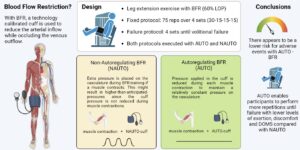This blog provides an overview of a recently published article about the application of blood flow restriction (BFR) and the differences between automatic and non-automatic regulating pressures in terms of safety and performance.
Why is this study important?
The application of blood flow restriction (BFR) in strength training has been expanding into both performance and health care settings. With BFR, a cuff is used to reduce blood flow to the exercising limb, thereby reducing the inflow of oxygen, while simultaneously accumulating metabolites such as lactate. However, despite the growing supportive body of evidence, there is still a lack of definitive guidelines on best practices regarding the implementation of BFR in resistance exercise. While this might not be a case for concern in healthy individuals, it might compromise safety when applied in patients with an altered response in terms of heart rate, blood pressure, or perception (e.g., higher discomfort or perceived exertion).
To prevent potential adverse events from occurring and make this type of training accessible for a variety of individuals, personalized limb occlusion pressures (LOP) are recommended to limit excessive stress on the vascular system. However, as the LOP is determined at rest, it does not account for muscle contractions, thereby producing higher-than-anticipated pressures during training, which might increase the perceived effort and discomfort, and enhance the risk for an adverse event. With autoregulated devices, this increase in pressure is considered by releasing air during each muscle contraction, whereas extra air is pumped into the cuffs in between contractions, keeping the total pressure to the vasculature relatively constant. To what extent the choice of autoregulated cuffs affects safety and training responses has never been investigated before.
Therefore, our study aimed to compare the acute differences between auto- (AUTO) and non-autoregulation (NAUTO) of applied pressures considering adverse effects, performance, cardiovascular and perceptual responses during a training protocol with a fixed number of repetitions and another until volitional failure.
How did the study go about this?
Healthy adults without prior BFR-experience completed four sessions in which they did a leg extension exercise with BFR. The first two sessions consisted of a fixed protocol (set 1: 30 reps, set 2-4: 15 reps), randomized with either AUTO first and NAUTO in the second session, or vice versa. In session three and four they completed a protocol with four sets until volitional failure, again with either AUTO or NAUTO first and the other pressure application second.
Heart rate, blood pressure, level of exertion and discomfort were measured in between each set, whereas the level of muscle soreness was measured after 24h. Performance was evaluated by means of the amount of repetitions during the failure protocol, while adverse events were defined as unintended or detrimental effects during or after the exercise, prohibiting participants to continue with the exercise.
What did this study find?
AUTO appears to reduce the risk for adverse events, with the odds ratio of adverse events occurring in AUTO being almost three times lower compared to NAUTO BFR training in physically active adults. While the majority of adverse events consisted of pre-syncopal symptoms (e.g. lightheadedness, pallor and excessive sweating), numbness and exercise intolerance were also reported. It can be hypothesized that autoregulated cuffs mitigate the risk for an adverse event as this pressure-application is able to keep the total pressure on the vasculature relatively constant, compared to the non-autoregulated cuffs, which allow for a higher-than-anticipated pressure during each muscle contraction, despite using individualized %LOPs.
In line with this, AUTO enabled participants to perform significantly more repetitions when exercising until volitional failure, induced less muscle soreness after 24h and was perceived to be significantly less uncomfortable.
What are the key take-home points?
As clinicians look to incorporate BFR into their practice, understanding of the different ways that it can be applied is essential to improve outcomes and/or reduce incidence of adverse events. Our study supports the use of autoregulation of applied pressure in BFR as it appears to enhance performance and safety during training.

Authors And Affiliations
Ewoud Jacobs(1), Nicholas Rolnick(2), Evi Wezenbeek1, Lenka Stroobant(3), Robbe Capelleman(1), Nele Arnout(3), Erik Witvrouw(1), Joke Schuermans(1)
- Ghent University Faculty of Medicine and Health Sciences, Department of Rehabilitation Sciences, Belgium
- The Human Performance Mechanic, Lehman College, USA
- Ghent University Hospital, Department of Orthopaedics and Traumatology, Belgium